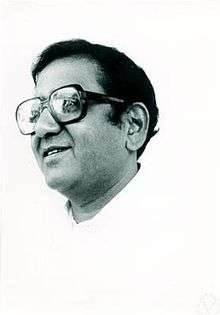Veeravalli S. Varadarajan
| Veeravalli S. Varadarajan | |
|---|---|
 | |
| Born | May 1937 (age 79) |
| Nationality | Indian |
| Fields | Mathematics |
| Institutions | UCLA |
| Alma mater | Presidency College, Madras |
| Doctoral advisor | C. R. Rao |
| Known for | Trombi–Varadarajan theorem |
| Notable awards | Onsager Medal |
Veeravalli S. Varadarajan (born May 1937) is an Indian mathematician at UCLA who has worked in many areas of mathematics, including Lie groups and their representations, quantum mechanics, differential equations, and supersymmetry.
Biography
Varadarajan received his undergraduate degree in 1957 from Presidency College, Madras and his doctorate in 1960 from the Indian Statistical Institute in Calcutta, under the supervision of C. R. Rao. He was one of the "famous four" (the others were R. Ranga Rao, K. R. Parthasarathy, and S. R. Srinivasa Varadhan ) in ISI during 1956-1963.[1] After short periods at the Institute for Advanced Study and the University of Washington, Seattle he joined the Department of Mathematics at UCLA in 1965.
Contributions
Varadarajan's early work, including his doctoral thesis, was in the area of probability theory. He then moved into representation theory where he has done some of his best known work. In the 1980s, he wrote a series of papers with Donald Babbitt on the theory of differential equations with irregular singularities. His latest work has been in supersymmetry.
He introduced Kostant–Parthasarathy–Ranga Rao–Varadarajan determinants along with Bertram Kostant, K. R. Parthasarathy and R. Ranga Rao in 1967,[2] the Trombi–Varadarajan theorem[3] in 1972 and the Enright–Varadarajan modules[4] in 1975.
Recognition
He was awarded the Onsager Medal in 1998 for his work. He was recognized along with 23 Indian and Indian American members "who have made outstanding contributions to the creation, exposition advancement, communication, and utilization of mathematics" by the Fellows of the American Mathematical Society program in November 1, 2012.[5]
Bibliography
- Varadarajan, V. S. (1984), Lie groups, Lie algebras, and their representations, Springer Verlag, ISBN 978-0387909691; 1st edition. 1974.[6]
- Varadarajan, V. S. (1977), Harmonic analysis on real reductive groups, Springer-Verlag[7]
- Gangolli, Ramesh; Varadarajan, V. S. (1983), Harmonic analysis of spherical functions on real reductive groups, Springer-Verlag[8]
- Varadarajan, V. S. (1999), An Introduction to Harmonic Analysis on Semisimple Lie Groups, Cambridge University Press; 1st edition. 1989.[9]
- Varadarajan, V. S. (1999), The selected works of V. S. Varadarajan, Providence, R.I.: American Mathematical Society, ISBN 978-0-8218-1068-2, MR 1647109
- Varadarajan, Veeravalli S. Supersymmetry for mathematicians: an introduction. Vol. 11. American Mathematical Society, 2004.
- Varadarajan, Veeravalli S. Geometry of quantum theory. Springer Science+Business Media, 2007.
- Ferrara, Sergio; Fioresi, Rita; Varadarajan, Veeravalli S. (2011). Supersymmetry in Mathematics and Physics: UCLA Los Angeles, USA 2010. Springer Verlag. doi:10.10007/978-3-642-21744-9. ISBN 978-3-642-21743-2. LCCN 2011934804.
- Varadarajan, V. S. (2006). Euler Through Time: A New Look at Old Themes. American Mathematical Society. ISBN 9780821835807.[10]
References
- ↑ Kalyan Bidhan Sinha and B. V. Rajarama Bhat. "Veeravalli S. Varadarajan" (PDF). Louisiana State University.
- ↑ K. R. Parthasarathy, R. Ranga Rao, and V. S. Varadarajan. "Representations of complex semi-simple Lie groups and Lie algebras." The Annals of Mathematics 85.3 (1967): 383-429
- ↑ Trombi, P. C., and V. S. Varadarajan. "Asymptotic behaviour of eigen functions on a semisimple Lie group: The discrete spectrum." Acta Mathematica 129.1 (1972): 237-280.
- ↑ Enright, Thomas J., and V. S. Varadarajan. "On an infinitesimal characterization of the discrete series." The Annals of Mathematics 102.1 (1975): 1-15.
- ↑ "American Mathematical Society Honors 23 Indians". Nov 1, 2012. India-West. Archived from the original on December 23, 2012. Retrieved Dec 19, 2012.
- ↑ Knapp, A. W. (1975). "Review: Lie groups, Lie algebras, and their representations, by V. S. Varadarajan; and Compact Lie groups and their representations, by D. P. Želobenko" (PDF). Bull. Amer. Math. Soc. (N.S.). 81 (5): 865–872. doi:10.1090/s0002-9904-1975-13866-3.
- ↑ Herb, Rebecca A. (1979). "Review: Harmonic analysis on real reductive groups, by V. S. Varadarajan" (PDF). Bull. Amer. Math. Soc. (N.S.). 1 (2): 398–401. doi:10.1090/s0273-0979-1979-14614-7.
- ↑ Barbasch, D. (1990). "Review: Harmonic analysis of spherical functions on real reductive groups, by R. Gangolli and V. S. Varadarajan" (PDF). Bull. Amer. Math. Soc. (N.S.). 23 (2): 598–604. doi:10.1090/s0273-0979-1990-15996-8.
- ↑ Wolf, Joseph A. (1993). "Review: An introduction to harmonic analysis on semisimple Lie groups, by V. S. Varadarjan" (PDF). Bull. Amer. Math. Soc. (N.S.). 28 (2): 367–370. doi:10.1090/s0273-0979-1993-00365-3.
- ↑ Roy, Ranjan (2008-01-01). "Review of Euler Through Time: A New Look at Old Themes". The American Mathematical Monthly. 115 (5): 469–473. JSTOR 27642523.
External links
- Veeravalli S. Varadarajan at the Mathematics Genealogy Project
- Home page of Veeravalli S. Varadarajan